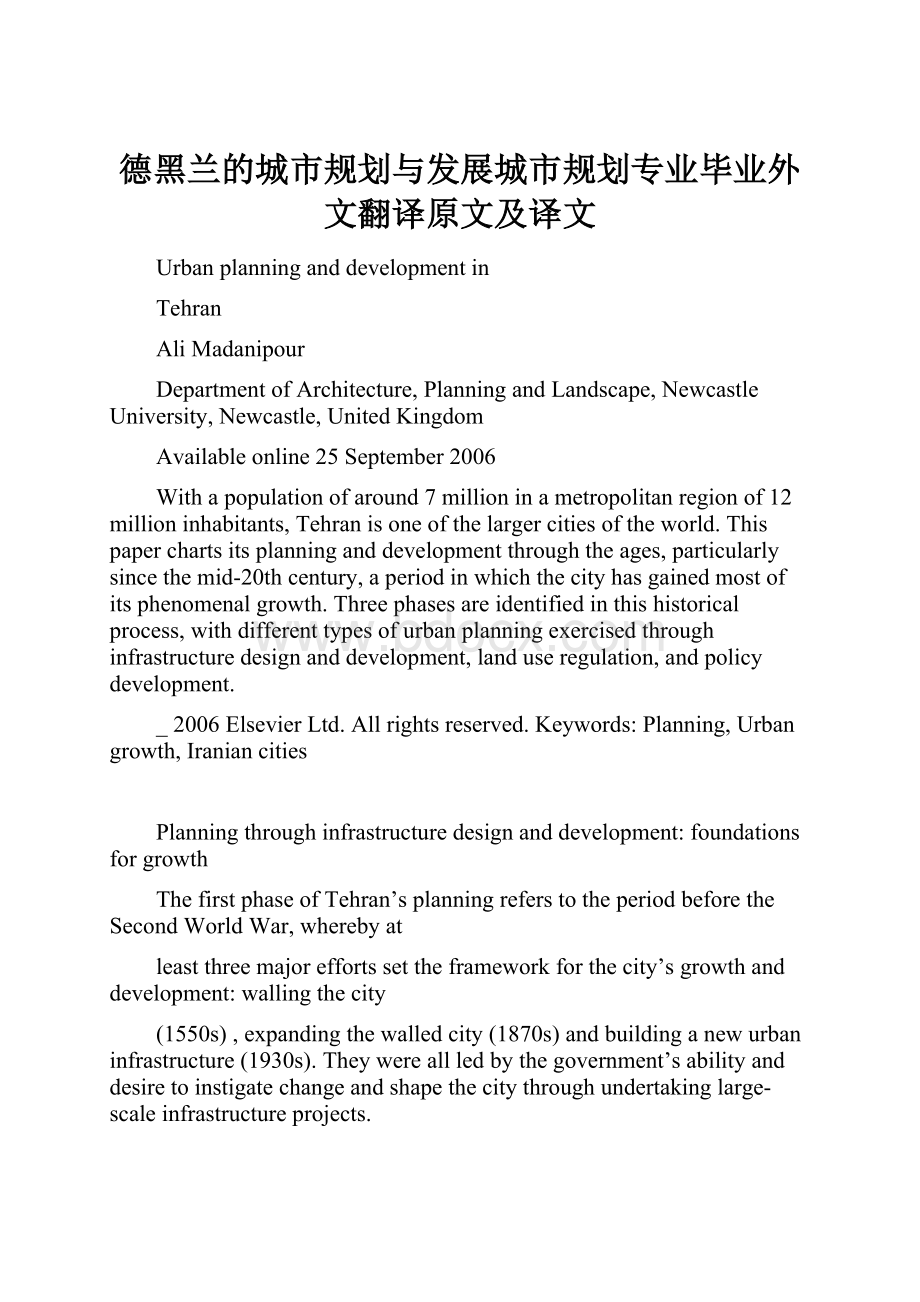 德黑兰的城市规划与发展城市规划专业毕业外文翻译原文及译文.docx
德黑兰的城市规划与发展城市规划专业毕业外文翻译原文及译文.docx
- 文档编号:29949672
- 上传时间:2023-08-03
- 格式:DOCX
- 页数:20
- 大小:35.13KB
德黑兰的城市规划与发展城市规划专业毕业外文翻译原文及译文.docx
《德黑兰的城市规划与发展城市规划专业毕业外文翻译原文及译文.docx》由会员分享,可在线阅读,更多相关《德黑兰的城市规划与发展城市规划专业毕业外文翻译原文及译文.docx(20页珍藏版)》请在冰豆网上搜索。

德黑兰的城市规划与发展城市规划专业毕业外文翻译原文及译文
Urbanplanninganddevelopmentin
Tehran
AliMadanipour
DepartmentofArchitecture,PlanningandLandscape,NewcastleUniversity,Newcastle,UnitedKingdom
Availableonline25September2006
Withapopulationofaround7millioninametropolitanregionof12millioninhabitants,Tehranisoneofthelargercitiesoftheworld.Thispaperchartsitsplanninganddevelopmentthroughtheages,particularlysincethemid-20thcentury,aperiodinwhichthecityhasgainedmostofitsphenomenalgrowth.Threephasesareidentifiedinthishistoricalprocess,withdifferenttypesofurbanplanningexercisedthroughinfrastructuredesignanddevelopment,landuseregulation,andpolicydevelopment.
_2006ElsevierLtd.Allrightsreserved.Keywords:
Planning,Urbangrowth,Iraniancities
Planningthroughinfrastructuredesignanddevelopment:
foundationsforgrowth
ThefirstphaseofTehran’splanningreferstotheperiodbeforetheSecondWorldWar,wherebyat
leastthreemajoreffortssettheframeworkforthecity’sgrowthanddevelopment:
wallingthecity
(1550s),expandingthewalledcity(1870s)andbuildinganewurbaninfrastructure(1930s).Theywereallledbythegovernment’sabilityanddesiretoinstigatechangeandshapethecitythroughundertakinglarge-scaleinfrastructureprojects.
TehranwasavillageoutsidetheancientcityofRay,whichlayatthefootofmountDamavand,thehighestpeakinthecountry,andattheintersectionoftwomajortradehighways:
theeast–westSilkRoadalongthesouthernedgeofAlburzmountainsandthenorth–southroutethatconnectedtheCaspianSeatothePersianGulf.RayhadbeeninhabitedforthousandsofyearsandwasthecapitaloftheSeljukdynastyinthe11thcentury;however,itdeclinedattheendofthemedievalperiod,whenTehranstartedtogrow(Lockhart,1960).
Thefirstlarge-scaletownplanningexerciseinTehranwasundertakenin1553,withtheconstructionofabazaarandcitywalls,whichweresquareandhadgatesonfoursides,inaccordancewiththepatternofancientPersiancities(Barthold,1984).Thissettheframeworkforotherdevelopmentsthatfollowed,andthecitygrewinsignificance,eventuallytobeselectedin1785asthecapitaloftheQajardynasty(1779–1925).
Onbecomingthecapital,thecityswelledbycourtiersandsoldiers,whowerefollowedbytradesandservices.Fromapopulationof15,000attheendofthe18thcentury,Tehrangrewtenfoldbythe1860s,witha10thofitsinhabitantsnowlivingoutsidetheoldwalls(Ettehadieh,1983).Thecountry’smilitarydefeatsinitsencounterswithBritainandRussiahadengenderedaprocessofreform,whichwasnowbeingextendedtothecapitalcity.Thesecondlarge-scaletownplanningexerciseinTehran,therefore,wasconductedforaccommodatinggrowthandintroducingmodernizationandreform.Startingin1868andlastingfor12years,newcitywalls,intheformofaperfectoctagonwith12gates,wereconstructed,whichweremoreusefulforgrowthmanagementandtaxcollectionthanfortheirdefensivevalue.Selectionasthecapitalcityandthesetransformations,whichincludedanewcentralsquare,newstreets,abank,aninstituteoftechnology,ahospital,atelegraphhouse,hotelsandEuropean-styleshops,were,accordingtoaBritishobserver,a‘‘twofoldrenaissance’’forTehran(Curzon,1892,p.300).
Thecitycontinuedtogrowandpressureformodernizationintensified,whichwasmanifestedintheConstitutionalRevolutionof1906.Amodernmunicipalitywasestablishedin1910,transformingtheoldsystemofurbangovernance.AftertheFirstWorldWar,thePahlavidynastycametopowerandthislastedfrom1925to1979.Thenewregime’semphasiswasonsecularismandnationalism,whichwerereflectedinadministrativecentralization,modernizationofthearmy,expansionofbureaucracy,developmentofatransportnetwork,integrationofregionsintoanationalmarket,andrestructuringtownsandcities(Abrahamian,1982).The1930switnessedwidespreadroad-wideningschemesthattoreapartthehistoricurbanfabric,makingthemaccessibletomotorvehicles.ThecityofTehranthuswentthroughitsthirdmajortownplanningexercise.Thecitywallsofthe1870swerefartoorestrictiveforagrowingcity.By1932,populationdensityhaddoubledto105personsperhectareandathirdofthepopulationlivedoutsidethewalls.Inadditiontodemographicpressure,thearrivalofmotorvehicles,theregime’sdesiretocontrolurbanpopulationsandtomodernizetheurbaninfrastructureledtoasubstantialtransformationofthecapital,inwhichitwas‘‘radicallyre-plannedandre-built’’(Lockhart,1939,p.11).Newboulevardswerebuiltontheruinsofthecitywallsandmoats,aspartofatransportnetworkof218kmofnewroads.Thewalledroyalcompoundwasfragmentedandreplacedbyanewgovernmentquarter;retailerswereencouragedtomovetonewstreetsandtoabandontheoldstreetsofthebazaar;andnewbuildingsandinstitutionssprangupalloverthecity.Thenewstreetnetworkwasimposedonthewindingstreetsofoldneighborhoods,withtheaimsofunifyingthespaceofthecity,overcomingthetraditionalfactionalsocialstructure,easingthemovementofgoods,servicesandmilitaryforces,strengtheningthemarketeconomyandsupportingthecentralizationofpower.Thecitywasturnedintoanopenmatrix,whichwasamajorstepinlayingthefoundationsforfurthermodernizationandfutureexpansion.Theimmediateresultwasthegrowthofthecityfrom310,000inhabitantsin1932to700,000in1941.
Theselarge-scaleurbanplanninganddevelopmentphasesofTehranwerealleffortsatmodernization,instigatingandmanagingradicalchange.However,whilethefirstphasehaduseddistinctivelyancientPersianimageryandlocalexpertise,thesecondandthirdphasesemployedEuropeanimagesandexperts,primarilyfromFranceandGermany.Whattheseearlytownplanningeffortssharedwasthattheywereallenvisagingaparticularnewformandimplementingitthroughthe(re)developmentoftheurbanenvironment;theywereallplansforamajorseriesofphysicalchangesexecutedinarelativelyshortperiodoftime.
Thereformsinthesecondhalfofthe19thcenturyopenedupthecity’ssocietyandspacetoneweconomicandculturalpatterns,andunleashedcentrifugalanddialecticforcesthatexplodedintwomajorrevolutions.Economically,thecitystartedtobeintegratedintotheworldmarketasaperipheralnode.Embracingthemarketeconomydividedthecityalongthelinesofincomeandwealth,whilenewculturalfaultlinesemergedalonglifestyleandattitudetowardstraditionandmodernity.Richandpoor,whousedtolivesidebysideintheoldcity,werenowseparatedfromoneanotherinapolarizingcity.Moreover,modernizerswelcomedlivinginnewneighborhoodsandfrequentednewstreetsandsquares,whiletraditionalistscontinuedtoliveandworkintheolderpartsofthecity.Eversince,theseeconomicandculturalpolarizations—andtheirassociatedtensions—havecharacterizedIran’surbanconditions.
Planningthroughland-useregulation:
harnessingspeculativedevelopment
ThesecondtypeofplanningtoemergeinTehranwasinthe1960s,whichsawthepreparationofplans
toregulateandmanagefuturechange.Thecityhadgrowninsizeandcomplexitytosuchanextentthat
itsspatialmanagementneededadditionaltools,whichresultedinthegrowingcomplexityofmunicipal
organization,andinthepreparationofacomprehensiveplanforthecity.
AftertheSecondWorldWar,duringwhichtheAlliedforcesoccupiedthecountry,therewasaperiodofdemocratization,followedbypoliticaltensionsofthestartofthecoldwar,andstruggles
overthecontrolofoil.Thisperiodwasendedin1953byacoupdetatthatreturnedtheShahto
power,whothenactedasanexecutivemonarchforthenext25years.Withhighbirthratesandanintensificationofrural–urbanmigration,Tehran—andotherlargecities—grewevenfasterthanbefore.By1956,Tehran’spopulationroseto1.5million,by1966to3million,andby1976to4.5million;itssizegrewfrom46km²in1934to250km²in1976(Kariman,1976;Vezarat-eBarnamehvaBudgeh,1987).
Revenuesfromtheoilindustryrose,creatingsurplusresourcesthatneededtobecirculatedandabsorbedintheeconomy.Anindustrializationdrivefromthemid-1950screatedmanynewjobsinbigcities,particularlyinTehran.Thelandreformsofthe1960sreleasedlargenumbersofruralpopulation
fromagriculture,whichwasnotabletoabsorbtheexponentialdemographicgrowth.Thisnewlabour
forcewasattractedtocities:
tothenewindustries,totheconstructionsectorwhichseemedtobealwaysbooming,toservicesandtheconstantlygrowingpublicsectorbureaucracy.Tehran’sroleasthe
administrative,economic,andculturalcentreofthecountry,anditsgatewaytotheoutsideworld,wasfirmlyconsolidated.
UrbanexpansioninpostwarTehranwasbasedonunder-regulated,private-sectordriven,speculativedevelopment.Demandforhousingalwaysexceededsupply,andasurplusoflaborandcapitalwasalwaysavailable;hencetheflourishingconstructionindustryandtherisingpricesoflandandpropertyinTehran.Thecitygrewinadisjointedmannerinalldirectionsalongtheoutgoingroads,integratingthesurroundingtownsandvillages,andgrowingnewsuburbansettlements.Thisintensifiedsocialsegregation,destroyedsuburbangardensandgreenspaces,andleftthecitymanagersfeelingpowerless.Adeputymayorofthecityin1962commentedthatinTehran,‘‘thebuildingsandsettlementshavebeendevelopedbywhomeverhaswantedinwhateverwayandwherevertheyhavewanted’’,creatingacitythatwas‘‘infactanumbero
- 配套讲稿:
如PPT文件的首页显示word图标,表示该PPT已包含配套word讲稿。双击word图标可打开word文档。
- 特殊限制:
部分文档作品中含有的国旗、国徽等图片,仅作为作品整体效果示例展示,禁止商用。设计者仅对作品中独创性部分享有著作权。
- 关 键 词:
- 德黑兰 城市规划 发展 专业 毕业 外文 翻译 原文 译文
 冰豆网所有资源均是用户自行上传分享,仅供网友学习交流,未经上传用户书面授权,请勿作他用。
冰豆网所有资源均是用户自行上传分享,仅供网友学习交流,未经上传用户书面授权,请勿作他用。


 《贝的故事》教案4.docx
《贝的故事》教案4.docx
